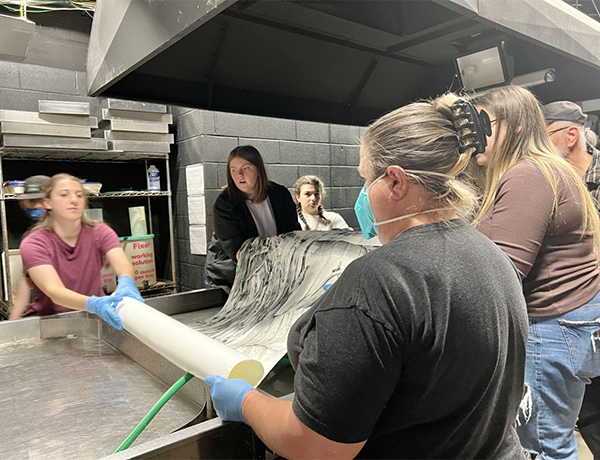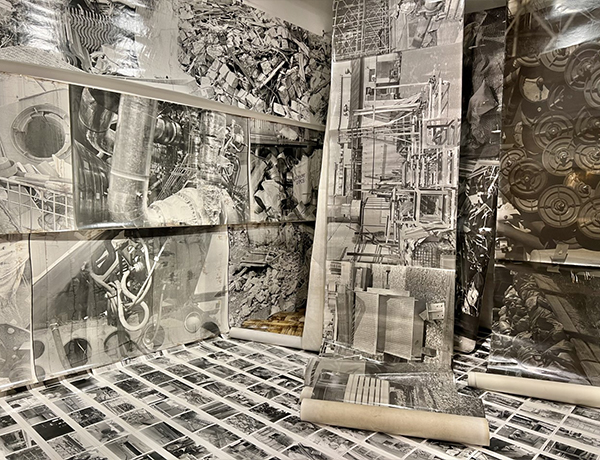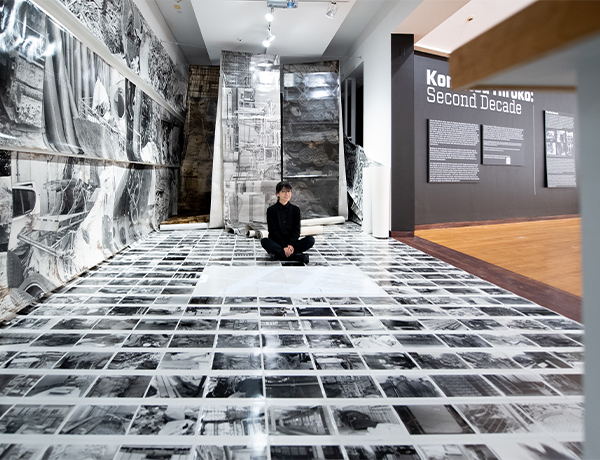Hartford Art School Partners with Award-Winning Photographer



An immersive photography exhibit—where photos cover every square inch of wall space and lie under your feet with each step you take—is open now through Dec. 10 at the University of Hartford’s Joseloff Gallery.
The work is by award-winning Japanese photographer Komatsu Hiroko, who also spent two weeks in residency at UHart’s Hartford Art School to build the exhibit and hold workshops with students. One piece featured in the show was completed by Komatsu and UHart’s senior photography majors: a 50-foot-long photo that took six hours and large horse troughs to develop in the HAS darkroom.
A recent NPR piece goes behind the scenes of the exhibit and the student’s photo development with the artist.
“Komatsu Hiroko: Second Decade” is the artist’s first large-scale exhibition in the U.S. and also includes handmade artist books, photograms, and work on 8mm film, all in black and white. Her work depicts the environmental chaos and excessive waste that take over sites of industry in her home city of Tokyo. The show’s layout reflects that as well; large, uncut rolls of photographs hang from the ceiling, creating a “photo forest,” while other prints obscured by plastic wrap stretch over boxes.
The public is invited to view the exhibit at the gallery for free Monday-Thursday, 12-6 p.m., and Friday-Saturday, 1-5 p.m.
Born in Kanagawa, Japan, in 1969, Komatsu began her career as an experimental noise musician and only started working with photography in the mid-2000s after participating in a darkroom workshop led by the accomplished photographer Kanemura Osamu, her now partner. Feeling that she needed to “catch up,” from 2010 to 2011 she rented the space of a former real estate office in Tokyo and gave herself the challenge of producing one new exhibition per month.
And so was born her singular installation method, in which black-and-white analog photographs of different sizes coat the environment so that visitors walk on, move through, and become completely enveloped in the materials of photography.
“While traditional exhibition displays encourage visitors to ‘read’ individually framed images in succession, that becomes impossible here,” says Carrie Cushman, the Edith Dale Monson Director and Curator of the Galleries at HAS. “The viewer is continually pulled back to the totality of the environment, where they are forced to rely on senses other than vision to learn from the space.”
The theme of knowledge production and acquisition—and what might be taken for granted in those processes—runs through the other works on display in the exhibition. Lines of text are meticulously cut out of books and contained in glass bottles; frottage rubbings and their photogrammed counterparts distort notions of photographic evidence; and documentary videos of musical concerts are soundless. All were created since 2020, the start of Komatsu’s second decade as a committed photographer.
The artist books in the exhibition are on loan from dieFirma in New York, where they are available for purchase. The immersive photographic installation in the exhibition travels to the Joseloff from the Davis Museum at Wellesley College, where it was on display earlier this year in the exhibition Komatsu Hiroko: Creative Destruction. An online catalogue for the Davis Museum exhibition, supported by a grant from the Japan-U.S. Friendship Commission and edited by Cushman, can be found here.
Cushman will also introduce the works on view in the exhibition and discuss Komatsu’s place in the world of contemporary art Thursday, Nov. 3, at 5 p.m. at the Joseloff Gallery.
“Komatsu Hiroko: Second Decade” is generously sponsored the Joseloff Gallery Programs Fund and the Edith Dale Monson Director Curator Fund held by Hartford Art School Endowment, Inc.
Carrie Cushman, Edith Dale Monson Director and CuratorWhile traditional exhibition displays encourage visitors to ‘read’ individually framed images in succession, that becomes impossible her. The viewer is continually pulled back to the totality of the environment, where they are forced to rely on senses other than vision to learn from the space.”